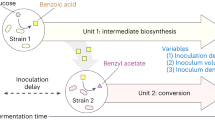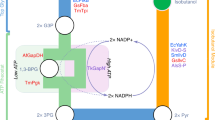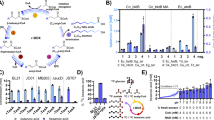Abstract
1,4-Butanediol (BDO) is an important commodity chemical used to manufacture over 2.5 million tons annually of valuable polymers, and it is currently produced exclusively through feedstocks derived from oil and natural gas. Herein we report what are to our knowledge the first direct biocatalytic routes to BDO from renewable carbohydrate feedstocks, leading to a strain of Escherichia coli capable of producing 18 g l−1 of this highly reduced, non-natural chemical. A pathway-identification algorithm elucidated multiple pathways for the biosynthesis of BDO from common metabolic intermediates. Guided by a genome-scale metabolic model, we engineered the E. coli host to enhance anaerobic operation of the oxidative tricarboxylic acid cycle, thereby generating reducing power to drive the BDO pathway. The organism produced BDO from glucose, xylose, sucrose and biomass-derived mixed sugar streams. This work demonstrates a systems-based metabolic engineering approach to strain design and development that can enable new bioprocesses for commodity chemicals that are not naturally produced by living cells.
This is a preview of subscription content, access via your institution
Access options
Subscribe to this journal
Receive 12 print issues and online access
$259.00 per year
only $21.58 per issue
Buy this article
- Purchase on Springer Link
- Instant access to full article PDF
Prices may be subject to local taxes which are calculated during checkout





Similar content being viewed by others
References
Carole, T.M., Pellegrino, J. & Paster, M.D. Opportunities in the industrial biobased products industry. Appl. Biochem. Biotechnol. 113–116, 871–885 (2004).
Kroschwitz, J.I. & Howe-Grant, M. Encyclopedia of Chemical Technology (John Wiley and Sons, New York, 1993).
Nakamura, C.E. & Whited, G.M. Metabolic engineering for the microbial production of 1,3-propanediol. Curr. Opin. Biotechnol. 14, 454–459 (2003).
Altaras, N.E. & Cameron, D.C. Metabolic engineering of a 1,2-propanediol pathway in Escherichia coli. Appl. Environ. Microbiol. 65, 1180–1185 (1999).
Atsumi, S. et al. Metabolic engineering of Escherichia coli for 1-butanol production. Metab. Eng. 10, 305–311 (2008).
Lindberg, P., Park, S. & Melis, A. Engineering a platform for photosynthetic isoprene production in cyanobacteria, using Synechocystis as the model organism. Metab. Eng. 12, 70–79 (2010).
Qian, Z.G., Xia, X.X. & Lee, S.Y. Metabolic engineering of Escherichia coli for the production of putrescine: a four carbon diamine. Biotechnol. Bioeng. 104, 651–662 (2009).
Lee, S.J., Song, H. & Lee, S.Y. Genome-based metabolic engineering of Mannheimia succiniciproducens for succinic acid production. Appl. Environ. Microbiol. 72, 1939–1948 (2006).
Moon, T.S., Yoon, S.H., Lanza, A.M., Roy-Mayhew, J.D. & Prather, K.L. Production of glucaric acid from a synthetic pathway in recombinant Escherichia coli. Appl. Environ. Microbiol. 75, 589–595 (2009).
Rathnasingh, C., Raj, S.M., Jo, J.E. & Park, S. Development and evaluation of efficient recombinant Escherichia coli strains for the production of 3-hydroxypropionic acid from glycerol. Biotechnol. Bioeng. 104, 729–739 (2009).
Lee, K.H., Park, J.H., Kim, T.Y., Kim, H.U. & Lee, S.Y. Systems metabolic engineering of Escherichia coli for L-threonine production. Mol. Syst. Biol. 3, 149 (2007).
Park, J.H., Lee, K.H., Kim, T.Y. & Lee, S.Y. Metabolic engineering of Escherichia coli for the production of L-valine based on transcriptome analysis and in silico gene knockout simulation. Proc. Natl. Acad. Sci. USA 104, 7797–7802 (2007).
Hong, S.H. & Lee, S.Y. Metabolic flux analysis for succinic acid production by recombinant Escherichia coli with amplified malic enzyme activity. Biotechnol. Bioeng. 74, 89–95 (2001).
Reed, J.L., Vo, T.D., Schilling, C.H. & Palsson, B.O. An expanded genome-scale model of Escherichia coli K-12 (iJR904 GSM/GPR). Genome Biol. 4, R54 (2003).
Cho, A., Yun, H., Park, J.H., Lee, S.Y. & Park, S. Prediction of novel synthetic pathways for the production of desired chemicals. BMC Syst. Biol. 4, 35 (2010).
Hatzimanikatis, V. et al. Exploring the diversity of complex metabolic networks. Bioinformatics 21, 1603–1609 (2005).
Henry, C.S., Broadbelt, L.J. & Hatzimanikatis, V. Discovery and analysis of novel metabolic pathways for the biosynthesis of industrial chemicals: 3-hydroxypropanoate. Biotechnol. Bioeng. 106, 462–473 (2010).
Mavrovouniotis, M.L. Group contributions for estimating standard gibbs energies of formation of biochemical compounds in aqueous solution. Biotechnol. Bioeng. 36, 1070–1082 (1990).
Burk, M.B., Burgard, A.P., Osterhout, R.E. & Sun, J. Microorganisms for the production of 1,4-butanediol. International Bureau patent WO/2010/030711 (2010).
Saito, N. et al. Metabolite profiling reveals YihU as a novel hydroxybutyrate dehydrogenase for alternative succinic semialdehyde metabolism in Escherichia coli. J. Biol. Chem. 284, 16442–16451 (2009).
Söhling, B. & Gottschalk, G. Purification and characterization of a coenzyme-A-dependent succinate-semialdehyde dehydrogenase from Clostridium kluyveri. Eur. J. Biochem. 212, 121–127 (1993).
Söhling, B. & Gottschalk, G. Molecular analysis of the anaerobic succinate degradation pathway in Clostridium kluyveri. J. Bacteriol. 178, 871–880 (1996).
Valentin, H.E., Zwingmann, G., Schonebaum, A. & Steinbuchel, A. Metabolic pathway for biosynthesis of poly(3-hydroxybutyrate-co-4-hydroxybutyrate) from 4-hydroxybutyrate by Alcaligenes eutrophus. Eur. J. Biochem. 227, 43–60 (1995).
Tian, J., Bryk, R., Itoh, M., Suematsu, M. & Nathan, C. Variant tricarboxylic acid cycle in Mycobacterium tuberculosis: identification of alpha-ketoglutarate decarboxylase. Proc. Natl. Acad. Sci. USA 102, 10670–10675 (2005).
Jewell, J.B., Coutinho, J.B. & Kropinski, A.M. Bioconversion of propionic, valeric, and 4-hydroxybutyric acids into the corresponding alcohols by Clostridium acetobutylicum NRRL 527. Curr. Microbiol. 13, 215–219 (1986).
Nair, R.V., Bennett, G.N. & Papoutsakis, E.T. Molecular characterization of an aldehyde/alcohol dehydrogenase gene from Clostridium acetobutylicum ATCC 824. J. Bacteriol. 176, 871–885 (1994).
Sivaraman, K., Seshasayee, A., Tarwater, P.M. & Cole, A.M. Codon choice in genes depends on flanking sequence information–implications for theoretical reverse translation. Nucleic Acids Res. 36, e16 (2008).
Scherf, U. & Buckel, W. Purification and properties of 4-hydroxybutyrate coenzyme A transferase from Clostridium aminobutyricum. Appl. Environ. Microbiol. 57, 2699–2702 (1991).
Burgard, A.P., Pharkya, P. & Maranas, C.D. OptKnock: a bilevel programming framework for identifying gene knockout strategies for microbial strain optimization. Biotechnol. Bioeng. 84, 647–657 (2003).
Snoep, J.L. et al. Differences in sensitivity to NADH of purified pyruvate dehydrogenase complexes of Enterococcus faecalis, Lactococcus lactis, Azotobacter vinelandii and Escherichia coli: implications for their activity in vivo. FEMS Microbiol. Lett. 114, 279–283 (1993).
Kim, Y., Ingram, L.O. & Shanmugam, K.T. Dihydrolipoamide dehydrogenase mutation alters the NADH sensitivity of pyruvate dehydrogenase complex of Escherichia coli K-12. J. Bacteriol. 190, 3851–3858 (2008).
Menzel, K., Zeng, A.P. & Deckwer, W.D. Enzymatic evidence for an involvement of pyruvate dehydrogenase in the anaerobic glycerol metabolism of Klebsiella pneumoniae. J. Biotechnol. 56, 135–142 (1997).
Iuchi, S. & Lin, E.C. arcA (dye), a global regulatory gene in Escherichia coli mediating repression of enzymes in aerobic pathways. Proc. Natl. Acad. Sci. USA 85, 1888–1892 (1988).
Stokell, D.J. et al. Probing the roles of key residues in the unique regulatory NADH binding site of type II citrate synthase of Escherichia coli. J. Biol. Chem. 278, 35435–35443 (2003).
Pereira, D.S., Donald, L.J., Hosfield, D.J. & Duckworth, H.W. Active site mutants of Escherichia coli citrate synthase. Effects of mutations on catalytic and allosteric properties. J. Biol. Chem. 269, 412–417 (1994).
Toth, J., Ismaiel, A.A. & Chen, J.S. The ald gene, encoding a coenzyme A-acylating aldehyde dehydrogenase, distinguishes Clostridium beijerinckii and two other solvent-producing clostridia from Clostridium acetobutylicum. Appl. Environ. Microbiol. 65, 4973–4980 (1999).
Riley, M. et al. Escherichia coli K-12: a cooperatively developed annotation snapshot–2005. Nucleic Acids Res. 34, 1–9 (2006).
Orencio-Trejo, M. et al. Metabolic regulation analysis of an ethanologenic Escherichia coli strain based on RT-PCR and enzymatic activities. Biotechnol. Biofuels. 1, 8 (2008).
Sprenger, G.A. & Lengeler, J.W. Analysis of sucrose catabolism in Klebsiella pneumoniae and in Scr+ derivatives of Escherichia coli K12. J. Gen. Microbiol. 134, 1635–1644 (1988).
Lutz, R. & Bujard, H. Independent and tight regulation of transcriptional units in Escherichia coli via the LacR/O, the TetR/O and AraC/I1–I2 regulatory elements. Nucleic Acids Res. 25, 1203–1210 (1997).
Donnelly, M.I., Millard, C.S., Clark, D.P., Chen, M.J. & Rathke, J.W. A novel fermentation pathway in an Escherichia coli mutant producing succinic acid, acetic acid, and ethanol. Appl. Biochem. Biotechnol. 70–72, 187–198 (1998).
Kim, Y., Ingram, L.O. & Shanmugam, K.T. Construction of an Escherichia coli K-12 mutant for homoethanologenic fermentation of glucose or xylose without foreign genes. Appl. Environ. Microbiol. 73, 1766–1771 (2007).
Mahadevan, R., Burgard, A., Famili, I., Van Dien, S. & Schilling, C. Applications of metabolic modeling to drive bioprocess development for the production of value-added chemicals. Biotechnol. Bioprocess Eng. 10, 408–417 (2005).
Sambrook, J., Fritsh, E.F. & Maniatis, T. Molecular Cloning: A Laboratory Manual (Cold Spring Harbor Laboratory, Cold Spring Harbor, New York, 1989).
Webb, E.C. Enzyme Nomenclature 1992: Recommendations of the Nomenclature Committee of the International Union of Biochemistry and Molecular Biology on the Nomenclature and Classification of Enzymes (Academic Press, San Diego, 1992).
Acknowledgements
Vector backbones were obtained from R. Lutz (Expressys). We thank Florida Crystals, Cargill, Bluefire Ethanol, Gruppo M&G and Verenium for providing crude sugar and biomass hydrolysate, B. Palsson, J. Keasling and G. Church for scientific advice throughout the project, and C. Schilling for critical reading of the manuscript.
Author information
Authors and Affiliations
Contributions
H.Y., R.H. and W.N. cloned and expressed BDO-pathway genes, performed bottle experiments and wrote the manuscript; C.P.-B. constructed the host strain and wrote the manuscript; A.B. conceived the project, performed simulations and wrote the manuscript; J.B. cloned and expressed BDO-pathway genes; J.K. and R.S. performed analytical work; J.D.T. conceived the project and performed simulations; R.E.O. performed simulations and wrote the manuscript; J.E. constructed the host strain and performed bottle experiments; S.T. and H.B.S. performed fermentations; S.A. developed and carried out enzyme assays; T.H.Y. analyzed 13C data for flux analysis; S.Y.L. conceived the project and wrote the manuscript; M.J.B. and S.V.D. conceived and directed the project and wrote the manuscript.
Corresponding author
Ethics declarations
Competing interests
Support for this work was provided by Genomatica, a for-profit company pursuing commercialization of the 1,4-butanediol process discussed here. All authors except S.Y.L. were employees of Genomatica at the time the work was performed. S.Y.L. is on the scientific advisory board of Genomatica.
Supplementary information
Supplementary Text and Figures
Supplementary Results, Supplementary Methods (PDF 748 kb)
Supplementary Data 1
List of reactions included in the genome-scale E. coli model used for OptKnock analysis. (XLS 261 kb)
Supplementary Data 2
Metabolite abbreviations and names, also indicating cytosolic or extracellular location. (XLS 89 kb)
Supplementary Data 3
OptKnock results. (XLS 34 kb)
Supplementary Data 4
Set of reaction operators used by the Biopathway Predictor algorithm and corresponding reaction diagrams. (XLSX 1670 kb)
Rights and permissions
About this article
Cite this article
Yim, H., Haselbeck, R., Niu, W. et al. Metabolic engineering of Escherichia coli for direct production of 1,4-butanediol. Nat Chem Biol 7, 445–452 (2011). https://doi.org/10.1038/nchembio.580
Received:
Accepted:
Published:
Issue Date:
DOI: https://doi.org/10.1038/nchembio.580
This article is cited by
-
Construction of a synthetic metabolic pathway for biosynthesis of 2,4-dihydroxybutyric acid from ethylene glycol
Nature Communications (2023)
-
Continuous succinic acid production from corn fiber hydrolysate by immobilized Actinobacillus succinogenes in a hollow fiber membrane packed‑bed biofilm reactor
Systems Microbiology and Biomanufacturing (2023)
-
Biosynthesizing structurally diverse diols via a general route combining oxidative and reductive formations of OH-groups
Nature Communications (2022)
-
Metabolic pathway design for growth-associated phenylalanine production using synthetically designed mutualism
Bioprocess and Biosystems Engineering (2022)
-
Development of shuttle vectors for rapid prototyping of engineered Synechococcus sp. PCC7002
Applied Microbiology and Biotechnology (2022)



